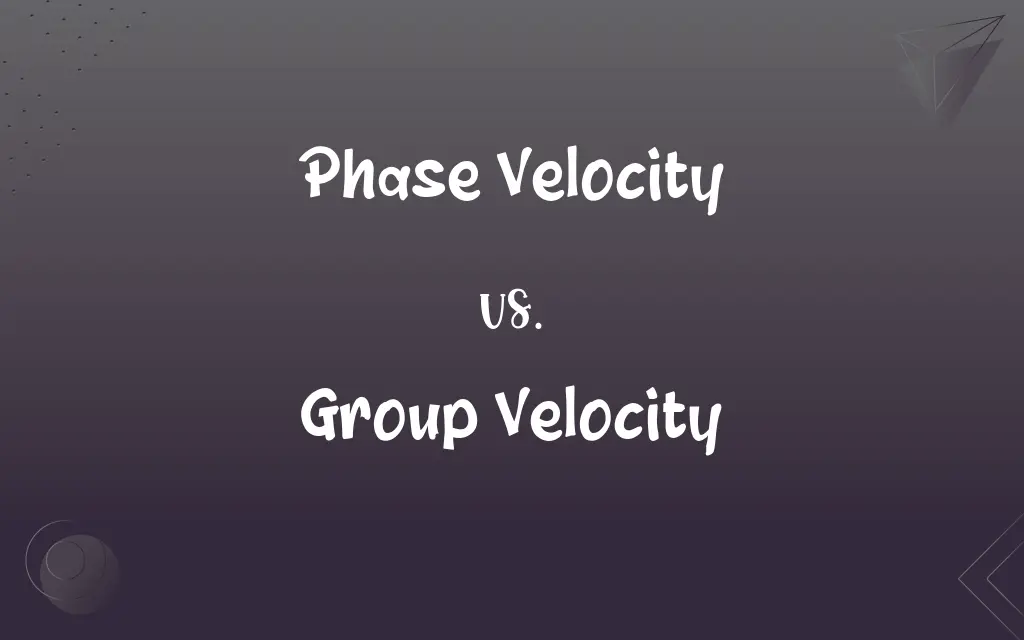Phase Velocity vs. Group Velocity: What's the Difference?
Edited by Aimie Carlson || By Harlon Moss || Updated on October 26, 2023
Phase velocity is the speed of a single wave's phase, while group velocity is the speed of a wave packet or group of waves.

Key Differences
Phase velocity represents the velocity at which a specific phase of a wave travels, typically depicted as the speed of the wave's crests or troughs. On the other hand, group velocity describes the speed of a group of waves, or more precisely, the envelope or wave packet that binds them together.
When considering waves in various mediums, phase velocity can sometimes exceed the speed of light in specific conditions. However, this does not transmit any real energy or information. Group velocity, in contrast, carries the actual energy of the wave packet and is restricted by the medium's constraints.
It's vital to understand that both phase velocity and group velocity are fundamental concepts in wave mechanics. In some scenarios, the two velocities can be equal, but in others, especially dispersive media, they can differ significantly.
Phase velocity can be mathematically defined as the ratio of the wave's frequency to its wavenumber. Meanwhile, group velocity is defined as the derivative of the wave's frequency with respect to its wavenumber. These definitions highlight their distinct natures and applications in wave theory.
Both phase velocity and group velocity are instrumental in various technological and natural phenomena. For instance, in fiber optics, understanding the relationship between these velocities ensures effective data transmission, whereas in oceanography, these concepts help in predicting wave behaviors.
ADVERTISEMENT
Comparison Chart
Definition
Speed of a specific phase of a wave.
Speed of an envelope or wave packet binding a group of waves.
Relation to Energy
Doesn't necessarily carry energy or information.
Carries the actual energy of the wave packet.
Mathematical Relation
Ratio of wave's frequency to its wavenumber.
Derivative of wave's frequency with respect to its wavenumber.
Behavior in Medium
Can exceed the speed of light in certain conditions without transmitting real energy or information.
Restricted by the medium's constraints and typically carries the wave's energy.
Applications
Used in understanding wave patterns and behaviors.
Essential in areas like fiber optics and predicting behaviors of groups of waves.
ADVERTISEMENT
Phase Velocity and Group Velocity Definitions
Phase Velocity
The velocity of a specific point or phase on a wave.
Using the phase velocity, we determined the wave's dispersion characteristics.
Group Velocity
The propagation velocity of the overall shape of a wave's amplitudes.
Studying the group velocity allowed us to determine how wave groups interacted.
Phase Velocity
The speed at which wave crests or troughs move through space.
Observing the phase velocity allowed us to predict the wave's behavior.
Group Velocity
The velocity of the envelope encompassing multiple waves.
Using group velocity, we could analyze the packet's overall movement.
Phase Velocity
The propagation velocity of a single oscillation in a waveform.
The phase velocity of the signal was consistent across the medium.
Group Velocity
The speed at which a wave packet or group of waves travels.
The group velocity was faster, indicating the energy was moving rapidly.
Phase Velocity
The speed at which a single wave phase propagates.
The phase velocity of the wave was measured by tracking a single crest.
Group Velocity
The rate at which wave energy propagates in a medium.
The group velocity was critical for optimizing data transmission in the fiber.
Phase Velocity
The rate of travel of any distinct phase within a medium.
The phase velocity provided insight into the medium's properties.
Group Velocity
The speed of a collective set of waves within a wave packet.
The group velocity differed from the individual wave speeds, showcasing dispersion.
FAQs
Which velocity carries the wave's energy: phase or group?
Group velocity typically carries the wave's actual energy.
What is group velocity?
Group velocity is the speed at which a wave packet or group of waves travels.
Can phase velocity be faster than light?
Yes, in certain mediums and conditions, phase velocity can exceed the speed of light, but it doesn't transmit real energy or information.
What is phase velocity?
Phase velocity is the speed at which a specific phase of a wave travels.
How do phase velocity and group velocity relate to each other?
Phase velocity pertains to a single wave phase, while group velocity concerns the entire wave packet.
How are phase velocity and group velocity calculated?
Phase velocity is the ratio of wave's frequency to wavenumber; group velocity is the derivative of wave's frequency concerning its wavenumber.
How do these velocities relate to wave frequency and wavelength?
Phase velocity is directly tied to frequency and wavelength ratios, while group velocity depends on frequency's rate of change concerning wavenumber.
Does group velocity always represent the speed of energy flow?
Typically, yes, but there are exceptions, especially in anomalous dispersion.
Can the two velocities ever be the same?
In non-dispersive media, phase and group velocities can be equal.
Why is understanding group velocity crucial in communication systems?
Group velocity influences signal speed and clarity, affecting data transmission quality.
Are these concepts only applicable to light waves?
No, phase and group velocities apply to various wave types, including sound and water waves.
Does the medium's density affect these velocities?
Yes, the properties of a medium can influence both phase and group velocities.
What happens to group velocity as wave frequency increases?
Group velocity's behavior with increasing frequency depends on the medium's dispersion properties.
In which medium do phase and group velocities differ significantly?
In dispersive media, these velocities can differ notably.
Where is group velocity critically considered?
In fields like fiber optics and oceanography, understanding group velocity is crucial.
How do phase and group velocities affect wave interference?
Their relationship and values can influence constructive and destructive interference patterns.
Is phase velocity relevant in everyday technology?
Yes, it plays roles in technologies like radio transmission and radar systems.
Can group velocity be negative?
In some specific conditions and materials, group velocity can be negative, leading to backward energy propagation.
How do these velocities impact sound waves?
Sound waves, like other waves, exhibit phase and group velocities that determine their speed and energy flow.
Why are both velocities important in wave theory?
They provide insights into wave behaviors, interactions, and energy propagation.
About Author
Written by
Harlon MossHarlon is a seasoned quality moderator and accomplished content writer for Difference Wiki. An alumnus of the prestigious University of California, he earned his degree in Computer Science. Leveraging his academic background, Harlon brings a meticulous and informed perspective to his work, ensuring content accuracy and excellence.
Edited by
Aimie CarlsonAimie Carlson, holding a master's degree in English literature, is a fervent English language enthusiast. She lends her writing talents to Difference Wiki, a prominent website that specializes in comparisons, offering readers insightful analyses that both captivate and inform.































































